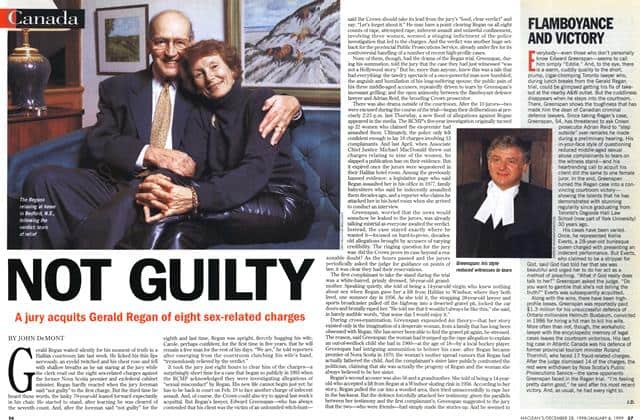Prologue
(Excerpted from Aphrodisiac: Sex, Politics, Power and Gerald Regan)

On the morning of December 18, 1998, Canadians a
The details of all those other allegations had been kept secret from the public — and the jurors — during Regan’s trial. But once the jury had finally begun deliberating the afternoon before, and after the judge had refused a defence request to continue the publication ban in place, the allegations — contained in testimony during Regan’s 1996 preliminary hearing and in pre-trial arguments while the jury was out of the room — came tumbling out.
What The Jury Didn’t Hear screamed the headlines in the December 18th Globe and Mail as well as on the front page of the Halifax Chronicle-Herald and Daily News. Other Stories Revealed: The Regan Investigation Found 35 Women Who Claimed They Were Assaulted, read one headline over a story inside the Daily News.
“The [court] documents,” wrote Kelly Toughill in the Toronto Star, “show that young women and teenagers complained that Regan attacked them in his car, in his office, in hotels and at political party functions throughout the 1950s, 1960s and 1970s.”
“By the time you read this,” added Heather Bird in the Toronto Sun, “there will likely only be 10 people [the jury] left in the province of Nova Scotia who haven’t heard all the dirty allegations against
Or possibly in all of Canada.
If Canadians were stunned by the stories they read in their newspapers that morning, they must have been even more shocked later that day when they turned on their television newscasts and learned that the jury had acquitted Regan of every one of the charges against him.
How could this have happened?
Civics lessons niceties about innocent-until-proven-guilty aside, there had been a public presumption for some time that Regan must be guilty. Nova Scotians had certainly heard the gossip. During Regan’s last unsuccessful electoral campaign in 1984, in fact, a local political gadfly had even gone door-to-door in Regan’s riding distributing pamphlets claiming “several women have told me of your sexual assaults upon them” and suggesting there were many more women with similar stories to tell.
In 1994, the CBC-TV current affairs program the fifth estate brought some of those “similar stories” to the attention of a national audience in a report entitled An Open Secret, which featured four women making on-camera allegations that Regan had come on to them.
The publication ban prevented journalists from reporting anything of substance that happened inside the courtroom during the long and winding legal road between the filing of charges in March 1995 and the actual beginning of his trial.
But, during the six-week trial itself, fifteen or more local and national, French and English, newspaper, radio, TV and magazine reporters did show up at court each day. For six weeks, they offered Canadians saturation coverage of the graphic, horrific details of the allegations the three women offered. “Mr. Regan was on top of me and he was trying to get my panties off…” “He had his penis near my vagina and he was attempting to penetrate me…” “I didn’t know what was going to happen. He was on top of me. Then I felt this terrible pain in my vagina. He put his penis in my vagina….”

Reading such testimony day after day — and probably without paying nearly as much attention to the
So they were understandably shocked when a jury decided he wasn’t.
What happened?
This book is an attempt to lay out exactly how the Regan case evolved and try to put the story of the allegations against him in the context not only of the events but also his own biography and recent social and political history of Nova Scotia.
I’ve chosen to incorporate most of the allegations against him into the narrative chronologically at the point where they’re supposed to have occurred in order to put their stories into some sort of context.
With the exception of a few instances that will be clear from the text, the details in the narrative come from court testimony, or police statements and notes referred to in
It’s important to make the point that — with the exception of the rape and attempted rape charges, on which Regan was acquitted — none of the other allegations against him have actually gone to trial. Some were not even the subject of charges. So Regan’s version of the events — or his denial that the alleged events ever happened — has never been heard in a courtroom. During the preliminary hearing into a number of charges that the judge eventually stayed, however, Regan’s lawyer did raise questions about the women’s versions of events. Those arguments are detailed in the section of Chapter 9 that deals with the preliminary hearing.
It’s important too to make the point that while Regan has been accused of much, he has been convicted of nothing.
This is the story of how that came to be.
(You can but the ebook version of
Aphrodisiac: Sex, Politics, Power and Gerald Regan
here.)







 STEPHEN KIMBER, a Professor of Journalism at the University of King's College in Halifax and co-founder of its MFA in Creative Nonfiction Program, is an award-winning writer, editor and broadcaster. He is the author of two novels and eight non-fiction books. Buy his books
STEPHEN KIMBER, a Professor of Journalism at the University of King's College in Halifax and co-founder of its MFA in Creative Nonfiction Program, is an award-winning writer, editor and broadcaster. He is the author of two novels and eight non-fiction books. Buy his books